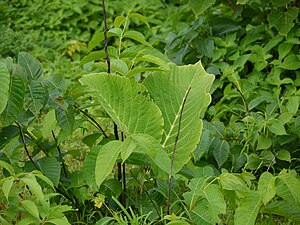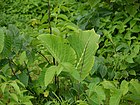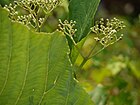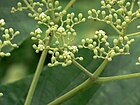Note: This is a project under development. The articles on this wiki are just being initiated and broadly incomplete. You can Help creating new pages.
Difference between revisions of "Leea macrophylla - Hastikarna"
(→References) |
|||
| Line 1: | Line 1: | ||
| − | |||
[[File:Large-leaved Leea (3871236586).jpg|thumb|right]] | [[File:Large-leaved Leea (3871236586).jpg|thumb|right]] | ||
| + | '''Leea macrophylla''' is a perennial plant with stems that becomes more or less woody. The plant is often shrub-like and occasionally tree-like, growing from a tuberous rootstock. | ||
| + | The plant is harvested from the wild for local use as a food, medicine and dye, It is planted in Sri Lanka for its medicinal use and may well also be cultivated in Malesia. | ||
==Uses== | ==Uses== | ||
{{Uses|Sexual debility}}, {{Uses|Guineaworm}}, {{Uses|Ringworm}}, {{Uses|Cancer}}. | {{Uses|Sexual debility}}, {{Uses|Guineaworm}}, {{Uses|Ringworm}}, {{Uses|Cancer}}. | ||
| Line 17: | Line 18: | ||
===Dravya=== | ===Dravya=== | ||
===Rasa=== | ===Rasa=== | ||
| − | |||
===Guna=== | ===Guna=== | ||
Revision as of 10:02, 1 June 2020
Leea macrophylla is a perennial plant with stems that becomes more or less woody. The plant is often shrub-like and occasionally tree-like, growing from a tuberous rootstock. The plant is harvested from the wild for local use as a food, medicine and dye, It is planted in Sri Lanka for its medicinal use and may well also be cultivated in Malesia.
Contents
- 1 Uses
- 2 Parts Used
- 3 Chemical Composition
- 4 Common names
- 5 Properties
- 6 Habit
- 7 Identification
- 8 List of Ayurvedic medicine in which the herb is used
- 9 Where to get the saplings
- 10 Mode of Propagation
- 11 How to plant/cultivate
- 12 Commonly seen growing in areas
- 13 Photo Gallery
- 14 References
- 15 External Links
Uses
Sexual debility, Guineaworm, Ringworm, Cancer.
Parts Used
Chemical Composition
The leaves contain an abundance of of phenolic constituents such as flavonoids, leucoanthocyanidins, p-hydroxybenzoic acid, syringic acid and gallic acid.[1]
Common names
| Language | Common name |
|---|---|
| Kannada | NA |
| Hindi | Hathikana |
| Malayalam | NA |
| Tamil | NA |
| Telugu | NA |
| Marathi | Gajakarni |
| Gujarathi | NA |
| Punjabi | NA |
| Kashmiri | NA |
| Sanskrit | Samudrika |
| English | Hathikana |
Properties
Reference: Dravya - Substance, Rasa - Taste, Guna - Qualities, Veerya - Potency, Vipaka - Post-digesion effect, Karma - Pharmacological activity, Prabhava - Therepeutics.
Dravya
Rasa
Guna
Veerya
Vipaka
Karma
Prabhava
Habit
Identification
Leaf
| Kind | Shape | Feature |
|---|---|---|
Flower
| Type | Size | Color and composition | Stamen | More information |
|---|---|---|---|---|
| {{{5}}} |
Fruit
| Type | Size | Mass | Appearance | Seeds | More information |
|---|---|---|---|---|---|
Other features
List of Ayurvedic medicine in which the herb is used
Where to get the saplings
Mode of Propagation
Seeds, Air layering, Cuttings.
How to plant/cultivate
Species in this genus generally succeed in full or partial sun, preferring a moist, fertile, well-drained soil[3]
Commonly seen growing in areas
Photo Gallery
References
- ↑ Chemistry
- ↑ [Morphology]
- ↑ Cultivation
External Links
- Ayurvedic Herbs known to be helpful to treat Sexual debility
- Ayurvedic Herbs known to be helpful to treat Guineaworm
- Ayurvedic Herbs known to be helpful to treat Ringworm
- Ayurvedic Herbs known to be helpful to treat Cancer
- Herbs with Leaves used in medicine
- Herbs with Fruits used in medicine
- Herbs with common name in Hindi
- Herbs with common name in Marathi
- Herbs with common name in Sanskrit
- Herbs with common name in English
- Habit - Shrub
- Index of Plants which can be propagated by Seeds
- Index of Plants which can be propagated by Air layering
- Index of Plants which can be propagated by Cuttings
- Herbs that are commonly seen in the region of Open vegetation
- Herbs that are commonly seen in the region of Dry forest
- Herbs
- Vitaceae




